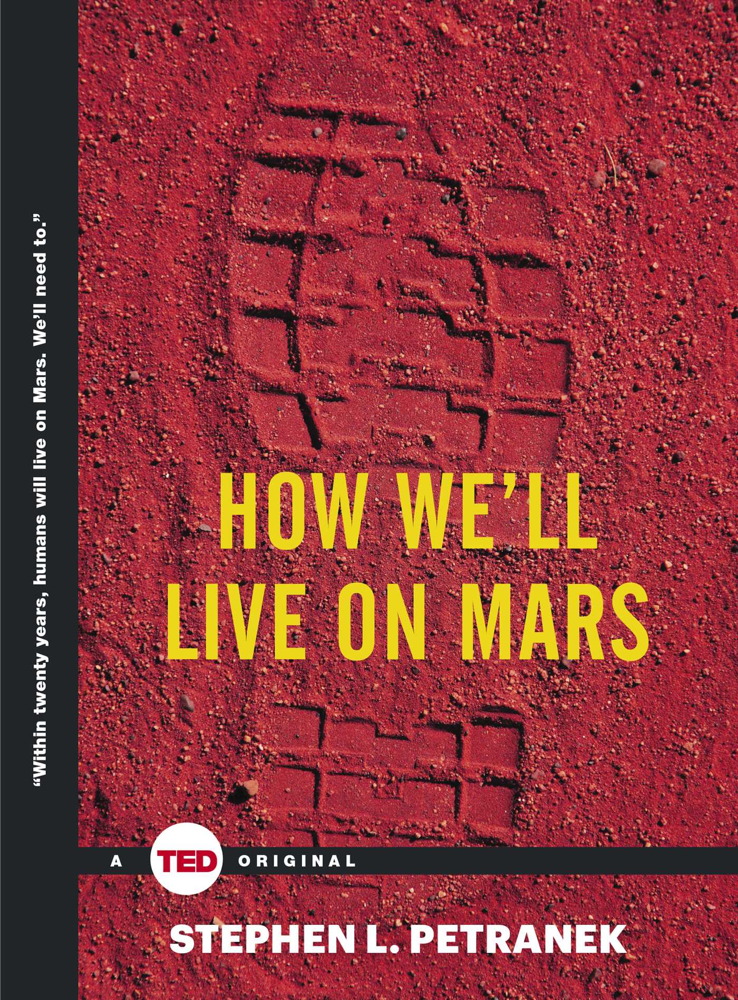'How We'll Live on Mars' (US 2015): Book Excerpt

Journalist Stephen Petranek thinks living on Mars is far more than science fiction — he believes it will happen within the next 20 years.
Like Petranek's TED talk of the same name, his book "How We'll Live on Mars" (Simon & Schuster, 2015) explores humankind's path so far to Mars, the industries needed to get there and thrive and the geo-engineering process that could make Mars a habitable world. According to Petranek, the seeds of all the technologies needed to colonize Mars exist, and a new private space race is what will get them into shape.
Petranek is an award-winning science journalist and currently the editor of Breakthrough Technology Alert. Throughout his 40-year career in publishing he has served as editor-in-chief of Discover magazine, editor of The Washington Post's magazine and a founding editor and editor-in-chief of This Old House magazine, among other positions. In the expert from Petranek's "How We'll Live On Mars" below, he lays out the pivotal moment when human explorers arrive on Mars, and what that historic giant leap might mean for humanity:
Nearly a decade of anticipation has come down to this moment: the spacecraft inches to the surface as the blast effect of braking rockets kicks up red dust. An Earth-bound audience waits eagerly as an announcer reminds them of a press conference that took place years earlier—a meeting that shocked the world and embarrassed NASA, which was still at least two years from testing its Mars spacecraft with humans aboard. On that day, the company behind this private effort to reach Mars revealed that it was about to build a series of huge rockets to transport people to Mars, and that within a decade it would launch one or two of them to effect the first manned landing on the Red Planet.
As Raptor 1 settles into a massive crater near the Martian equator, the astronauts aboard are already thinking ahead. Time is precious. If all has gone well with the first landing, Raptor 2 will follow within hours, carrying more explorers on board. First on the astronauts' punch list is the deployment of a base camp habitat, part of the enormous cargo the ships have carried. They must also inflate "buildings" — domed, pressurized tents made of exotic materials that will increase their living area and act as greenhouses in which to grow food.
Some environmental similarities exist between Earth and Mars. The Martian terrain looks a lot like certain parts of Earth—the dry valleys in Antarctica or the high deserts on Hawaiian volcanoes. Many other factors will prove to be extremely challenging. A day on Mars is only thirty-nine minutes and twenty-five seconds longer than a day on Earth, but a Martian year is far longer than one on Earth — 687 days — making seasons twice as long. Mars's orbit is oval, meaning seasonal variations between winter and summer are more severe than those on Earth; in the southern hemisphere, summers are warmer and winters are colder. Ultimately these Martian settlers intend to establish two bases, one below the equator in the southern hemisphere for summers and one north of the equator for winters.
But now, within twenty-four hours, the first humans to walk on Mars must begin their most important task: finding water. They must determine if there is, as NASA landers and orbiters have predicted, enough water in the surface soil, called regolith, to support both their hydration needs as well as serve as a stock for making more of the oxygen they will consume. The astronauts purposely landed in a crater that a NASA orbiter spotted as having a smooth sheet of pure water ice. If that sheen isn't ice, they will need to find a second site nearby with a high percentage of ice in the regolith. If that sort of ice cannot be found nearby, the astronauts will deploy ground-penetrating radar to find underground water, and then drill.
Get the Space.com Newsletter
Breaking space news, the latest updates on rocket launches, skywatching events and more!
Long before the next ships arrive (two years from this moment), these astronauts must build more permanent structures, possibly out of bricks they make from the regolith. Although today is sunny and relatively warm — about 50 degrees Fahrenheit — temperatures will plunge as darkness approaches, turning the environment into something akin to a bad night at the South Pole. Landing near the equator allows the astronauts to take advantage of milder temperatures that can reach 70 degrees Fahrenheit on a summer day. But at night, the temperature easily reaches minus 100 degrees, and structures will be needed to insulate the astronauts from the cold as well as to protect them from solar rays that are almost unrestricted by the thin atmosphere.
In the event that everything goes wrong — they cannot find a good water supply, the radiation effects are more severe than predicted, or one of the ships is badly damaged on landing, they will hunker down and await a decent launch window for the long trip back to Earth. Otherwise, they are here to stay.

These first explorers, alone on a seemingly lifeless planet as much as 250 million miles away from home, have everything in common with the trailblazers who preceded them — the great explorers throughout history who scaled mountains and sailed oceans to create new lives. And yet, despite their commonality with explorers of years past, these spacefaring pioneers are in every way more important than any explorers who have ever preceded them. Their presence on Mars represents the greatest achievement of human intelligence.
Anyone who watched Neil Armstrong set foot on the moon in 1969 can tell you that, for a moment, the Earth stood still. The wonder and awe of that achievement was so incomprehensible that some people still believe it was staged on a Hollywood set. When astronauts stepped onto the moon, people started saying, "If we can get to the moon, we can do anything." They meant that we could do anything on or near Earth. Getting to Mars will have an entirely different meaning: If we can get to Mars, we can go anywhere.
The achievement will make dreamy science fiction like Star Wars and Star Trek begin to look real. It will make the moons of Saturn and Jupiter seem like reasonable places to explore. It will, for better or worse, create a wave of fortune seekers to rival those of the California gold rush. Most important, it will expand our vision as far from the bounds of Earth's gravity as we can imagine. When the first humans set foot on Mars, the moment will be more significant in terms of technology, philosophy, history, and exploration than any that have come before it, all because we will no longer be a one-planet species.
These explorers are the beginning of an ambitious plan, not just to visit Mars and establish a settlement but to reengineer, or terraform, the entire planet — to make its thin atmosphere of carbon dioxide rich enough in oxygen for humans to breathe, to raise its temperature from an average of minus 81 degrees Fahrenheit to a more tolerable 20 degrees, to fill its dry stream beds and empty lakes with water again, and to plant foliage that can flourish in its temperate zone on a diet rich in CO2. These astronauts will set in motion a process that might not be complete for a thousand years but will result in a second home for humans, an outpost on the farthest frontier. Like many frontier outposts before it, this one will eventually rival the home planet in resources, standard of living, and desirability.
These pathfinders have embarked on a journey that has implications far into the future. Their greater mission is to establish a spacefaring society that maintains a system of spaceports for rockets, allowing easy liftoff from a planet with low gravity. From there, humans can travel to the outer reaches of the solar system.
When these rockets land on Mars in the near future, it will be far more than a great moment for exploration. It will be nothing less than an insurance policy for humanity. There are real threats to the continuation of the human race on Earth, including our failure to save the home planet from ecological destruction and the possibility of nuclear war. Collision with a single asteroid could eliminate most life, and eventually our own sun will enlarge and destroy Earth. Long before that happens, we must become a spacefaring species, capable of living not only on another planet but ultimately in other solar systems. The first humans who emigrate to Mars are our best hope for the survival of our species. Their tiny base will grow into a settlement, and perhaps even a new species that will expand rapidly. The company which built the rocket that brought them there is building hundreds more rockets. The intention is to create a viable population of 50,000 within a few decades. They can preserve the collective wisdom and achievement of humanity even if those of us back on Earth are annihilated.
The truth is that it has been possible to reach Mars for at least thirty years. Within a decade or so of the Apollo 11 mission that landed the first humans on Earth's moon, we could have landed humans on the Red Planet. Almost every technology required has long been available. We simply have not chosen to pursue the opportunity.
The backstory of that mistake is worth understanding—how a single decision by one US president stunted space travel for decades, how we might have inspired two generations of earthlings with humankind's ability to deliver on almost anything our brains can imagine. Nearly five decades ago we had the ability to extend ourselves into the solar system and beyond.
Now private rocketry has opened a new window to the stars. Perhaps the need to explore is built into our DNA; homo sapiens began venturing out of Africa about 60,000 years ago, pushing the horizon until they populated the entire globe.
Exploration may be connected to human survival. But it has also led to colonization of lands already occupied, the devastation of cultures, and the plundering of resources.
The settlement of Mars is about to happen far sooner than most people realize, and in a nonregulated way. Most of this book is an examination of the astonishing fact that we have the capabilities to build on Mars. But this book is also a wakeup call. The potential is enormous, but the pitfalls are numerous. The time to think is now.
BUY "How We'll Live On Mars" >>
Follow us @Spacedotcom, Facebook and Google+.
Join our Space Forums to keep talking space on the latest missions, night sky and more! And if you have a news tip, correction or comment, let us know at: community@space.com.

Sarah Lewin started writing for Space.com in June of 2015 as a Staff Writer and became Associate Editor in 2019 . Her work has been featured by Scientific American, IEEE Spectrum, Quanta Magazine, Wired, The Scientist, Science Friday and WGBH's Inside NOVA. Sarah has an MA from NYU's Science, Health and Environmental Reporting Program and an AB in mathematics from Brown University. When not writing, reading or thinking about space, Sarah enjoys musical theatre and mathematical papercraft. She is currently Assistant News Editor at Scientific American. You can follow her on Twitter @SarahExplains.









